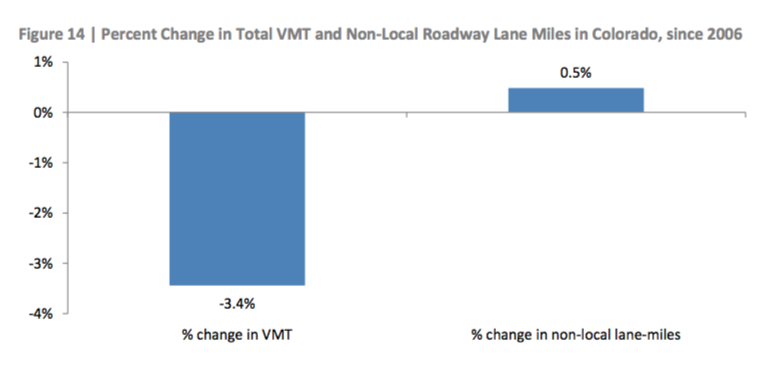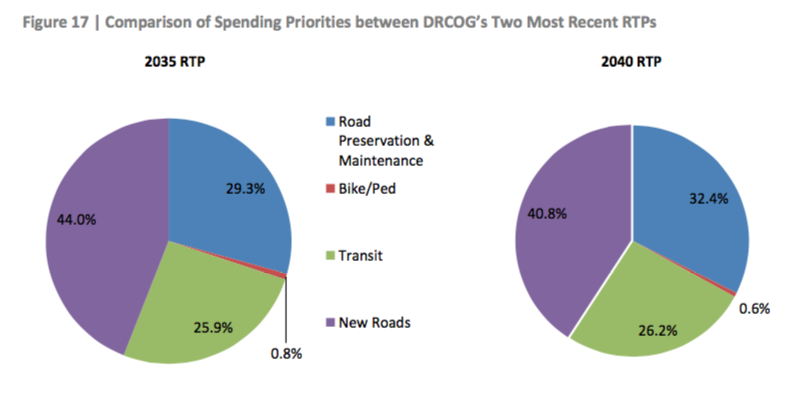Coloradans Are Driving Less, But Agencies Keep Spending on Expanding Roads

People in the Southwest are driving less and using transit more, but transportation spending doesn’t reflect those trends, according to a new report from the Southwestern Energy Efficiency Project.
Instead state DOTs are building more roads, as though nothing has changed. Meanwhile regional transportation agencies like the Denver Regional Council of Governments aren’t spending enough on pedestrian, bicycle, and transit projects to keep up with changing attitudes toward driving.
The report, Driving Trends and Transportation Funding in the West, covers Colorado, Arizona, Nevada, New Mexico, Utah and Wyoming. It drills down into each state’s largest metropolitan area to conclude that the Southwest’s latest regional transportation plans spend 72 percent of their funding for roadways, pretty much the same amount — 75 percent — they reserved for roads before 2007, when road travel began to drop.
From the report:
Less driving reduces demand for new roadways and lessens wear and tear on existing roads, both of which lead to lower expenditures on roadway infrastructure… In addition, to the extent that reduced [vehicle miles travelled] is connected to changes in urban form and travel behavior that lead to more walking and biking, there are important direct health benefits.
So why aren’t transportation planners adjusting their budget allocations to accommodate and support this trend? Public demand for bike lanes, public transit and safe pedestrian routes is growing at the same time that the public is driving less, yet the vast majority of transportation dollars are still earmarked for road construction.
Per capita, driving mileage — or vehicle miles traveled — in the Denver area has stagnated or dropped since peaking in 2006, according to the report. The average person drove about 25 miles per day that year, and drove about 24 per day in 2013, the most recent year with data available. Driving mileage per capita hasn’t been this low in the Denver region since 1993.
Yet DRCOG’s latest regional transportation plan, which prioritizes projects through 2040, doesn’t heed this shift — even though DRCOG predicts people will be driving less. Here’s how DRCOG prioritizes transportation projects now, compared to how it did five years ago:

“It’s not as if we don’t have a fairly built-out road network in the Denver metro region,” said co-author Mike Salisbury, a senior transportation associate with SWEEP. “Funds for roads dwarf money for other modes. We’re not gonna say, ‘You can’t drive anymore.’ What we want to see is options… making things like transit and other alternatives more available. Then people can decide for themselves what they do.”
As the number of miles Coloradans drive fell between 2006 and 2013, the number of miles traveled on public transit rose by 30 percent, Salisbury said. And RTD’s regional rail network won’t even be fully operational until next year.
“I think the main recommendation is that these agencies see that driving per capita is going down a lot, transit use is going up, yet our spending is stuck,” Salisbury said. “We’re really trying to push that conversation forward at the DRCOG level and the CDOT level. What we’re really trying to do is engage those metropolitan organizations, the DOTs, and reprioritize how we spend money.”
In some cases the report actually uses DRCOG and CDOT as models for other Southwestern states and regions. For example, DRCOG is the only regional transportation planning agency that adopted a goal to reduce VMT by 10 percent over the next 25 years. And Colorado is the only state of the bunch that actually publishes VMT projections — a recommendation SWEEP makes for other states “so that the public has an opportunity to understand how their transportation departments justify new roads.”
Still, there’s more shade than sun in the report. The report calls out CDOT’s insistence on using old projections to rationalize widening I-70 at a cost of $1.8 billion. Despite the decline in total VMT, the number of roadway miles keeps growing, along with the amount of money that could be used for sustainable transportation — and that needs to stop.


